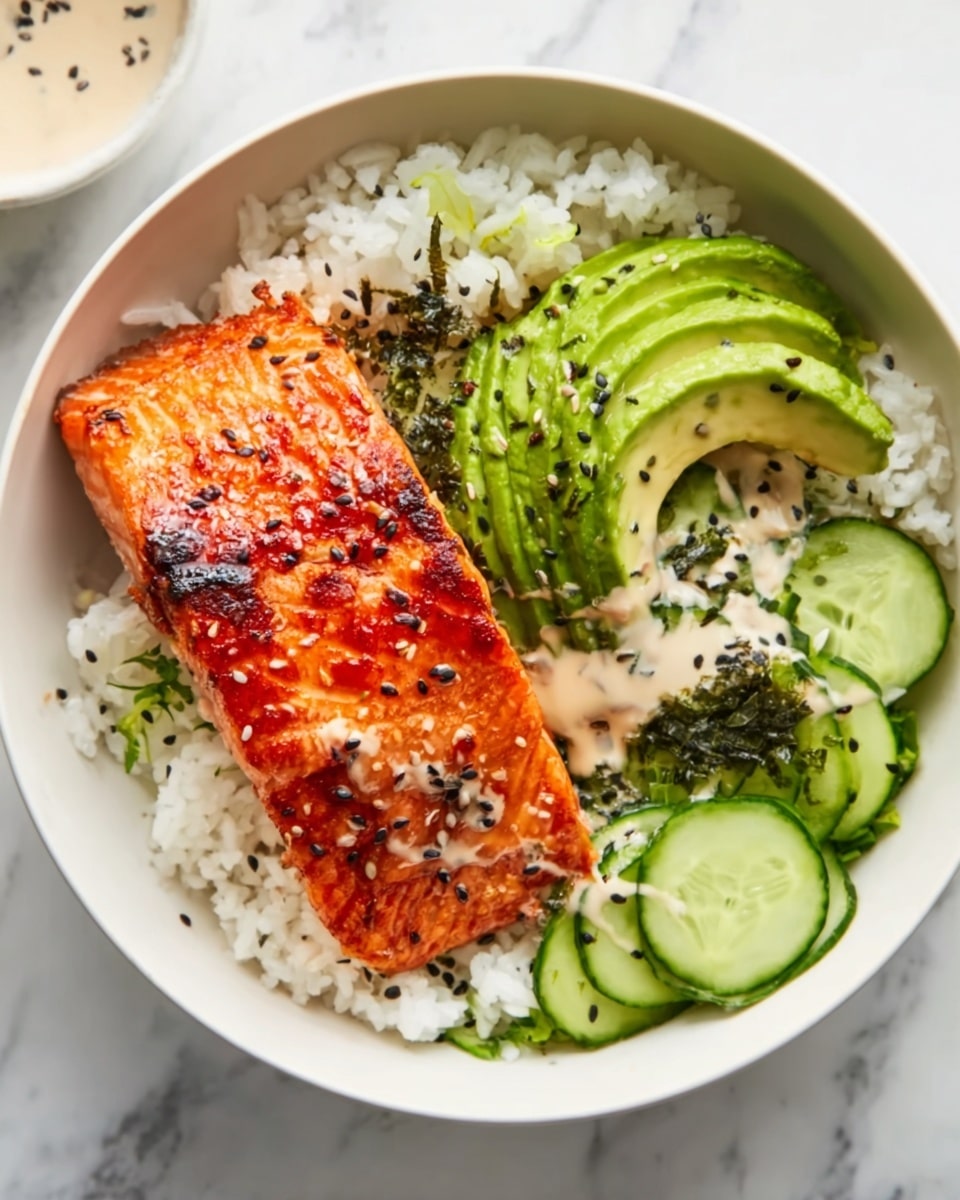Baked Salmon Sushi Bowl Recipe
Introduction
This Baked Salmon Sushi Bowl combines tender, savory salmon with fresh avocado and cucumber over a bed of steamed rice. It’s a quick and flavorful meal that brings the taste of sushi to your home kitchen without the fuss of rolling.

Ingredients
- 4 salmon filets (4-6 oz each)
- Kosher salt and ground black pepper, to taste
- 4-5 tablespoons soy sauce (substitute Tamari for gluten-free)
- 1-2 teaspoons chili garlic sauce (substitute Sriracha)
- 1-2 teaspoons avocado oil (substitute olive oil)
- 1/2 cup mayonnaise
- Additional 1-2 teaspoons chili garlic sauce (more as desired, substitute Sriracha)
- 4 cups cooked rice of your choice
- 2 avocados, sliced
- 2 cups English cucumber, sliced
- Furikake seasoning
- Extra soy sauce (or Tamari) for serving
Instructions
- Step 1: Preheat your oven to 400°F (200°C). Place the salmon filets on a baking sheet lined with parchment paper. Season both sides with kosher salt and ground black pepper.
- Step 2: In a small bowl, mix 4-5 tablespoons soy sauce, 1-2 teaspoons chili garlic sauce, and 1-2 teaspoons avocado oil. Brush the mixture over the salmon evenly.
- Step 3: Bake the salmon in the preheated oven for 12-15 minutes, or until the fish flakes easily with a fork.
- Step 4: While the salmon cooks, prepare the spicy mayo by mixing the mayonnaise with 1-2 teaspoons chili garlic sauce in a small bowl. Adjust the spice level to your preference.
- Step 5: Once the salmon is done, flake it gently into large chunks.
- Step 6: Assemble the bowls by dividing the cooked rice among four bowls. Top with the flaked salmon, sliced avocado, and cucumber slices.
- Step 7: Drizzle the spicy mayo over the bowls and sprinkle generously with furikake seasoning.
- Step 8: Serve with additional soy sauce or Tamari on the side for extra flavor if desired.
Tips & Variations
- Use sushi rice for a more authentic texture, or substitute with jasmine or basmati rice for a different flavor profile.
- For a gluten-free version, always use Tamari instead of soy sauce.
- Add pickled ginger or seaweed salad for more traditional sushi bowl toppings.
- Swap out the avocado oil for a neutral oil like grapeseed or olive oil if preferred.
Storage
Store leftover components separately in airtight containers in the refrigerator for up to 2 days. Salmon is best reheated gently in the oven or enjoyed cold. Assemble the bowl just before serving to keep the avocado fresh and preventing the rice from drying out.
How to Serve

Serve this delicious recipe with your favorite sides.
FAQs
Can I use fresh raw salmon instead of baking it?
This recipe is designed for baked salmon to ensure it’s cooked safely and easily. If you prefer raw salmon, make sure to use sushi-grade fish and follow safe handling practices, then adjust the recipe accordingly.
What can I use instead of furikake seasoning?
If you don’t have furikake, you can sprinkle toasted sesame seeds and a pinch of sea salt or use crushed nori sheets for a similar flavor and texture.
PrintBaked Salmon Sushi Bowl Recipe
A vibrant and flavorful Baked Salmon Sushi Bowl featuring tender baked salmon filets glazed with a spicy soy sauce, served over a bed of perfectly cooked rice and topped with creamy avocado, crisp cucumber, and a sprinkle of savory furikake seasoning. This easy-to-make bowl harmonizes Japanese-inspired flavors with a wholesome, satisfying meal.
- Prep Time: 10 minutes
- Cook Time: 12 minutes
- Total Time: 22 minutes
- Yield: 4 servings 1x
- Category: Main Course
- Method: Baking
- Cuisine: Japanese-inspired
- Diet: Gluten Free
Ingredients
Salmon and Sauce
- 4 salmon filets (4–6 oz each)
- Kosher salt and ground black pepper, to taste
- 4–5 tablespoons soy sauce (or Tamari for gluten-free)
- 1–2 teaspoons chili garlic sauce (or Sriracha)
- 1–2 teaspoons avocado oil (or olive oil)
- 1/2 cup mayonnaise
- 1–2 teaspoons chili garlic sauce (or Sriracha), extra for mayo
Base and Toppings
- 4 cups cooked rice (of your choice)
- 2 avocados, sliced
- 2 cups English cucumber, sliced
- Furikake seasoning, to taste
- Soy sauce (or Tamari for gluten-free), for serving
Instructions
- Preheat Oven and Prepare Salmon: Preheat your oven to 400°F (200°C). Line a baking sheet with foil or parchment paper to prevent sticking. Pat the salmon filets dry and season both sides lightly with kosher salt and ground black pepper.
- Make the Soy-Chili Glaze: In a small bowl, combine soy sauce, chili garlic sauce, and avocado oil. Whisk together until fully combined to create a flavorful glaze.
- Brush and Bake Salmon: Place salmon filets on the prepared baking sheet. Brush the tops generously with the soy-chili glaze. Bake in the preheated oven for 10-12 minutes, or until the salmon is cooked through and flakes easily with a fork.
- Prepare the Spicy Mayo: While the salmon bakes, mix the mayonnaise with 1-2 teaspoons of chili garlic sauce in a small bowl. Adjust the amount of chili sauce to your preferred spice level.
- Assemble the Sushi Bowls: Divide the cooked rice evenly among four bowls. Top each bowl with slices of baked salmon, avocado, and cucumber. Drizzle the spicy mayo over the top.
- Garnish and Serve: Sprinkle furikake seasoning liberally over each bowl for added umami and crunch. Serve with extra soy sauce or Tamari on the side for dipping or drizzling as desired.
Notes
- Use Tamari instead of soy sauce for a gluten-free version.
- Adjust the amount of chili garlic sauce to control the spice level.
- For extra flavor, marinate the salmon in the soy-chili glaze for 15 minutes before baking.
- Rice options include sushi rice, jasmine, or brown rice depending on preference.
- Furikake seasoning adds a traditional Japanese flavor but can be omitted or substituted with toasted sesame seeds.
Keywords: Baked Salmon, Sushi Bowl, Spicy Mayo, Furikake, Japanese Bowl, Gluten-Free, Easy Dinner, Healthy Recipe








